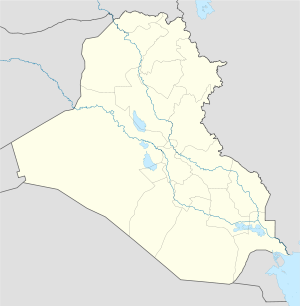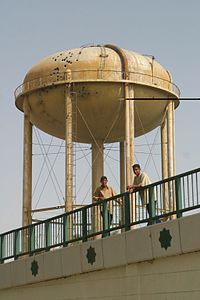- Nasiriyah
-
Nasiriyah
Arabic: الناصرية
An NāṣirīyahNasiriyah water treatment plant Coordinates: 31°03′N 46°16′E / 31.05°N 46.267°E Country  Iraq
IraqGovernorate Dhi Qar Governorate Founded 1840 Population (2003 Est.) - Total 560,200 Nasiriyah (Arabic: الناصرية; BGN: An Nāşirīyah; also spelled Nassiriya or Nasiriya) is a city in Iraq. It is on the Euphrates about 225 miles (370 km) southeast of Baghdad, near the ruins of the ancient city of Ur. It is the capital of the province of Dhi Qar. According to the 1987 census the city had a population of 265,937 people; the estimated population in 2003 was 560,200.
The population of Nasiriyah is nearly exclusively[clarification needed] Shī‘a Muslims with large[clarification needed] Mandaean and Sunni muslim communities, until 1951 the town was a home to a sizable Jewish community. After the failed uprising of 1991, many families were massacred by Saddam Hussein's forces whilst thousands fled from Iraq to other countries such as the United States, United Kingdom, Canada, Australia and Sweden.
Nasiriyah is the centre of a date-growing area, but many other agricultural products are produced here as well. The city's industries include boatbuilding, carpentry and silver working.
The old parts of the town are built mainly from sun-dried brick and this part of the town is still enclosed by a mud wall. The newer parts are dominated by standard Iraqi block buildings.
The city museum has a large collection of Sumerian, Assyrian, Babylonian, and Abbasid artifacts. The ruins of the ancient cities of Ur and Larsa are located nearby.
Contents
History
The city was founded in 1872 by Sheikh Nasir Al Sadoon of the Muntafiq tribal confederation, after whom it is named. During World War I the British conquered the city, controlled at the time by the Ottoman Empire, in July 1915. Some 400 British and Indian and up to 2,000 Turkish soldiers were killed in the battle for Nasiriyah on 24 July 1915.[1]
Nasiriyah is where the Iraqi Communist Party was founded around 1932. It was mostly dominated by secular and leftist groups, and the founder of the Iraqi Baath Party, Foud al-Rikaby, was from Nasiriyah. During 1932-1963 the city was the center for liberal and progressive thinking.
Some of the leading thinkers who grew up in that area were Aziz al-Syed Jasim, Aziz Abdul Sahab, Sadiq Atemish, Mohamed Ali al-Nasiri, along with many poets (e.g., Ayniah al-Husewani, Aryan Syed Khalif, etc), singers (e.g., Hazery Abu Aziz, Taleb al-Qayraqwli, Hussein Nameh, etc) and artists (Huessien al-Halali, Majed al-Najar, etc.).
During 1940s the city was the chamber for oppositions to monarchy and to the feudal system. Students union, Peasants association, and workers played an important role in sensitizing people to the nature of corruption and abuses which were committed by the government in Baghdad and its supporters. These associations under the leadership of the Communist Party were instrumental in setting the stage for July 14, 1958 Revolution. Hassan al-atybai and Aziz Al-Syed Jasim along with many intellectuals led the public celebrations which took place in many part of the governorate immediately after the Revolution.
During the 1991 Gulf War, Nasiriyah marked the furthest point to which coalition forces penetrated Iraq, with the United States 82nd Airborne Division reaching the main road just outside the city. In March 1991, following the American withdrawal at the war's end, the Shia population of Nasiriyah took part in the revolt against the rule of Saddam Hussein. The revolt was violently subdued by the Iraqi military with heavy loss of life and much physical damage.
Until the 2003 war, Nasiriyah was home to one of the biggest communities of Mandeans in Iraq.[2]
Iraq War (2003-2010)
Main article: Battle of NasiriyahIn March 2003, Nasiriyah was one of the first major battles of the 2003 invasion of Iraq. Phillip Mitchell of the International Institute for Strategic Studies described Nasiriyah's strategic importance to The Guardian: "Nasiriyah is a major administrative headquarters and is also [Iraqi General] Majid's military district headquarters. It is a major strategic crossing point of the Euphrates. For all those reasons Nasiriyah will be well defended, which will slow the Mech [invasion] down for a while."[3]
On March 23, a US convoy was ambushed near the city, killing 11 soldiers and resulting in multiple soldiers, including Private Jessica Lynch and Specialist Shoshana Johnson, becoming prisoners of war during the conflict. Heavy fighting took place between Iraqi forces and the 2nd Marine Expeditionary Brigade under the call sign "Task Force Tarawa" of the US Marine Corps between about March 23 and March 29, in which 18 Marines were killed and over 150 were wounded, including a number hit by friendly fire from Air Force A-10 aircraft,[4] but the Iraqi resistance was crushed fairly rapidly thereafter. The town has been relatively calm since the fall of Saddam Hussein. A truck bomb killed 19 Italian soldiers and 11 civilians in November 2003 (see 2003 Nasiriyah bombing), and clashes erupted here in April 2004 during the Mahdi uprising.
See also
References
- ^ Tucker, Spencer (2005). World War I: encyclopedia. ABC-CLIO. http://books.google.fr/books?id=B1cMtKQP3P8C&pg=RA2-PA829. Retrieved 2009-09-13.
- ^ Dabrowska, Karen (2008). Iraq Then and Now: A Guide to the Country and Its People. Bradt Travel Guides. http://books.google.fr/books?id=DhJ3lRnXyXcC&pg=PA262. Retrieved 2009-09-12.
- ^ Gains in south spur thrust in Baghdad - The Guardian
- ^ Marine captain faulted in friendly fire incident - CNN.com
External links
Coordinates: 31°03′N 46°16′E / 31.05°N 46.267°E
Districts of Iraq and capitals Al Anbar Governorate Al Muthanna Governorate Al-Khidhir District (Al-Khidhir) • Al-Rumaitha District (Al-Rumaitha) • Al-Salman District (Al-Salman) • Al-Samawa District (Samawa)Al-Qādisiyyah Governorate Afaq District (Afaq) • Al-Shamiya District (Al-Shamiya) • Diwaniya District (Diwaniya) • Hamza District (Hamza)Babil Governorate Al-Mahawil District (Al-Mahawil) • Al-Musayab District (Al-Musayab) • Hashimiya District (Hashimiya) • Hilla District (Hilla)Baghdad Governorate Basra Governorate Abu Al-Khaseeb District (Abu Al-Khaseeb) • Al-Midaina District (Al-Midaina) • Al-Qurna District (Al-Qurna) • Al-Zubair District (Al-Zubair) •
Basrah District (Basrah) • al-Faw District (al-Faw) • Shatt Al-Arab District (Shatt Al-Arab)Dhi Qar Governorate Al-Chibayish District (Al-Chibayish) • Al-Rifa'i District (Al-Rifa'i) • Al-Shatra District (Al-Shatra) • Nassriya District (Nassriya) • Suq Al-Shoyokh District (Suq Al-Shoyokh)Diyala Governorate Dohuk Governorate Amadiya District (Amadiya) • Dohuk District (Dohuk)• Sumel District (Sumel) • Zakho District (Zakho)Arbil Governorate Makhmur District (Makhmur) • Arbil • Koisanjaq District (Koisanja) • Shaqlawa District (Shaqlawa)• Soran District • Mergasur District • Choman DistrictKarbala Governorate Ain Al-Tamur District (Ain Al-Tamur) • Al-Hindiya District (Al-Hindiya) • Kerbala District (Kerbala)Kirkuk Governorate Maysan Governorate Ali Al-Gharbi District (Ali Al-Gharbi) • Al-Kahla District (Al-Kahla) • Al-Maimouna District (Al-Maimouna) • Al-Mejar Al-Kabi District (Al-Mejar Al-Kabi) • Amara District (Amarah) • Qal'at Saleh District (Qal'at Saleh)Najaf Governorate Ninawa Governorate Aqrah District (Aqrah) • Al-Ba'aj District (Al-Ba'aj) • Al-Hamdaniya District (Bakhdida) • Hatra District (Hatra) •Mosul District (Mosul) • Shekhan District (Ain Sifni) • Sinjar District (Sinjar) • Tel Afar District (Tel Afar) • Tel Keppe District (Tel Keppe)Salah ad Din Governorate Al-Daur District (Al-Daur) • Al-Shirqat District (Al-Shirqat) • Baiji District (Baiji) • Balad District (Balad) • Samarra District (Samarra) • Tikrit District (Tikrit) • Tooz District (Tooz)Sulaymaniyah Governorate Chamchamal District (Chamchamal) • Darbandokeh District (Darbandokeh) • Dokan District (Dokan) • Halabja District (Halabja) • Kalar District (Kalar) • Penjwin District (Penjwin) • Pshdar District (Pshdar) • Ranya District (Ranya) • Sharbazher District (Sharbazher) • Sulaymaniya District (Sulaymaniya)Wasit Governorate Al-Hai District (Al-Hai) • Al-Na'maniya District (Al-Na'maniya) • Al-Suwaira District (Al-Suwaira) • Badra District (Badra) • Kut District (Kut)Categories:- Populated places in Dhi Qar Governorate
- Populated places on the Euphrates River
- Populated places established in 1840
- Fertile Crescent
- District capitals of Iraq
- Cities in Iraq
Wikimedia Foundation. 2010.




